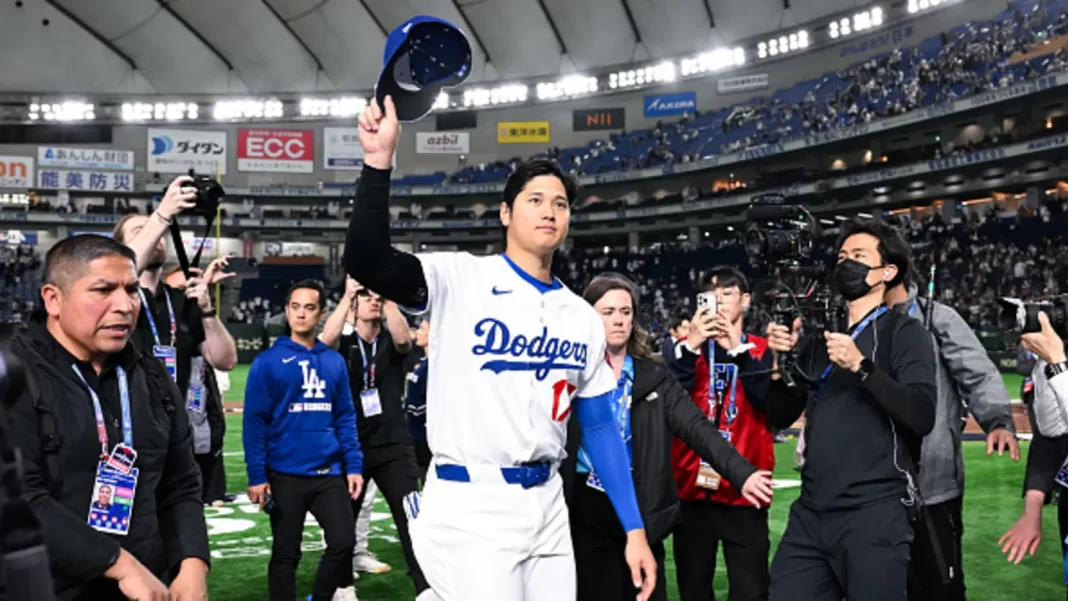On the morning of the second and final game of Major League Baseball’s Tokyo Series between the Chicago Cubs and Los Angeles Dodgers on March 19, a dusting of snow fell on Japan’s capital city — an extremely rare occurrence for a time of year more known for cherry blossom blooms.
But that didn’t dissuade more than a thousand people from lining up to shop at the 31,100-square-foot Fanatics-operated MLB store outside the Tokyo Dome when it opened that morning.
That is a reflection of the type of impact that Shohei Ohtani is having on MLB’s business in Japan, an impact that has only grown in size since he signed a then-professional sports record 10-year, $700 million contract with the Dodgers in December 2023, following that up with MLB’s first-ever 50 home run and 50 steal season, in addition to winning both the National League MVP and a World Series title.
Last year, Fanatics, which operates the MLB’s merchandise business globally, saw a 170% increase in MLB merchandise sales year-over-year in Japan, according to Nori Kawana, East Asia managing director for Fanatics. In the past five years, Ohtani-related merchandise has accounted for 57% of all MLB sales in MLB Store Japan and Fanatics Japan, while Dodgers merchandise sales are up more than 2,000% year-over-year since he signed with the team, Kawana said.
Japan has a deep baseball history and is the country’s most popular sport for both spectators and participants. MLB also has had a long connection to the country, dating back to barnstorming games that saw players like Babe Ruth and Lou Gehrig play in exhibition games in Japan to the now deeper relationship between MLB and Nippon Professional Baseball.
Noah Garden, MLB deputy commissioner of business and media, said Japan is by far the league’s largest commercial market outside of the U.S. and Canada, something he attributes to those long-term investments.
“It just doesn’t happen overnight,” Garden said. However, he added: “And then you’ve got this-once-in-a-lifetime talent.”
Garden said that when MLB looks around the globe, “the business stuff generally lags the fandom by a few ticks.”
In Japan, where MLB is “just scratching the surface,” Garden said, “the opportunities are exploding.”
The first game of this year’s Tokyo Series was watched by 25 million viewers in Japan, according to MLB, setting a new record for the most-watched game in the country — Japan’s population is roughly 125 million. The second game averaged more than 23 million viewers.
While it’s not an exact apples-to-apples comparison, the Dodgers-New York Yankees 2024 World Series averaged 15.8 million viewers in the U.S. (and 12.1 million in Japan where the games began in the morning).
MLB plans to feed that growing fanbase in Japan with content. The league has long had an office in the country, and recently expanded its original and translated Japanese content for the MLB app and on MLB.com. It is also adding a newsletter and a content hub that follows Japanese-born players. as well as updating its MLB Gameday product, which provides game tracking and advanced stats, to be in Japanese.
Garden said that a growing audience is changing the way the league is thinking about its next media rights contract, with both its international and domestic deals expiring after the 2028 season. “When the next set of deals are up, you’re going to find people that are looking for worldwide rights, especially the streamers,” Garden said. “The amount of people engaging with and watching the game internationally I think has opened everyone’s eyes.”
For the Tokyo Series, games were broadcast locally on over-the-air NTV, as well as streamed on Amazon Prime.
That also carries over to sponsorships, Garden said, with American companies seeing an opportunity to further break into the Japanese market while Japanese companies are able to not only do things with MLB now locally but reach U.S. consumers as well. In the last two years, MLB has signed 14 new sponsors in Japan, and the Tokyo Series was the league’s largest international sponsorship event ever, generating a 240% increase in revenue compared to the 2024 Seoul Series played in Seoul, South Korea.
“We’re benefitting from all that kind of converging at the same time,” Garden said.
Garden said the league expects the Tokyo Series to be “the most successful international game we’ve done financially.”
The two games between the Cubs and Dodgers were instant sell-outs, in addition to the exhibition games held between the MLB teams and local Japanese games. Demand was so high, the games were aired in roughly 150 movie theaters in Japan.
The Tokyo Series recorded the best merchandise sales of any MLB international event, with sales eclipsing the 2024 London Series by 320%, MLB said. Sales at the store at the Tokyo Dome surpassed every MLB All-Star Week ever, selling more than half a million products. Unsurprisingly, the most popular item was an Ohtani jersey with the Tokyo Series patch.
MLB Commissioner Rob Manfred told the New York Times that he expects the Tokyo Series to set records across the board for a league special event, and could bring in upwards of $35 million. However, he said the larger goal is to grow the league’s total business there: “We do believe there are payoffs in the B’s: billions,” Manfred told the Times.
Connecting Japanese fans with all MLB players, teams

That growth will only continue as Ohtani, alongside other Japanese-born players like the Dodgers’ Roki Sasaki and Yoshinobu Yamamoto, and the Cubs’ Shota Imanaga and Seiya Suzuki, continue to make an impact in MLB. But the challenge for MLB and its partners in reaching that lofty goal is to build up the rest of the league’s players in Japan as well.
David Leiner, president of trading cards for Fanatics Collectibles, where he oversees Topps, said that the fandom around baseball in Japan is undeniable, with plenty of support not only for the Japanese MLB stars but the local NPB teams as well.
Topps has grown its business into the eight figures in the country, Leiner said, “with Ohtani sprinkling a little accelerant into the growth.”
The company also holds the licenses for the Japanese baseball and soccer leagues, as well as other entertainment properties, and Leiner said Fanatics sees the potential for the market to generate upwards of nine figures.
Japanese baseball card collectors aren’t very different from American ones, Leiner said, but one of the significant differences is how much they look to support players from their country. “Do they want the Derek Jeter [card] or Mike Trout [card]? Of course, but they lean a little more towards the Japanese players in MLB, and there’s a lot of pride in that,” he said.
Leiner said that does lead to the fandom of teams that Japanese players played on, and that does stick over time — for example, there is a contingent of Seattle Mariners fans in Japan due to Ichiro Suzuki’s time with the team. But there are other examples of it being a fleeting phenomenon, as Japanese fans flocked to one player and then stopped following as closely when that player left MLB. Now, the growth of Japanese players, and their impact within the league, is helping to build a broader fandom for MLB.
Last season, there were 10 Japanese-born players on MLB rosters on Opening Day, the most since 2013 when there were 11. While that significantly trails some of the other countries represented in the league, like the Dominican Republic and Venezuela — which had 108 and 58 players on Opening Day rosters, respectively — few countries can match the star power of the current group of Japanese players. MLB has not yet required teams to finalize 2025 Opening Day rosters, but the number of Japanese players is expected to grow.
Kawana, who is based in Tokyo, said that while Japanese fans have historically been player-fandom focused, he is now seeing a growth in team fandom especially as it has become easier to follow those teams.
Having MLB teams on the ground hasn’t hurt either. Before this year, the last time MLB played official games in Japan was in 2019, and Garden said that the league is hoping that when it agrees to its new CBA, set to expire in 2026, it will come with “an even bigger [international] plan.”
MLB will host a slate of games in Monterrey, Mexico, later this month.
“These sorts of things are years in the making, and it takes a long time from participation at the youth level on up to really mature,” Garden said. “You’re seeing the culmination of it now, and this should usher in a new era of prosperity for MLB and baseball in Asia.”



